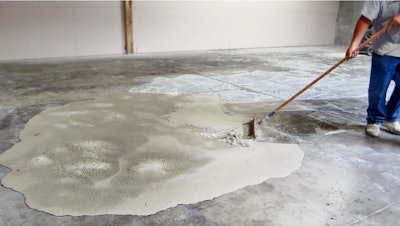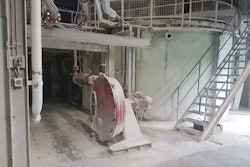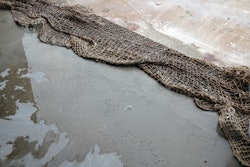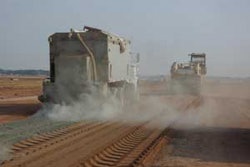
When working with concrete, most contractors have to face the reality of dealing with slurry wastewater. Unfortunately, concrete slurry is prohibited from being dumped straight down the drain, due to its harmful nature. With the Environmental Protection Agency’s (EPA) regulations and Occupational Safety and Health Administration’s (OSHA) new silica dust proposals, working with concrete slurry is becoming unavoidable. Thus, what is the proper method for slurry disposal?
 Pictured, an example of slurry seperation.Gelmaxx
Pictured, an example of slurry seperation.Gelmaxx
Since the majority of concrete slurry is composed of water, separating the water from the slurry drastically reduces the amount of waste and provides reusable, clean water. This can be achieved with the aid of a filter press, but the expensive equipment may not be practical for everyone. Instead, the use of slurry separators quickly accelerates slurry separation. Simply add the slurry separator, wait for the solids to drop to the bottom, and decant the water on top for reuse. Before disposing of the water, test the pH level to make sure the water is neutral and safe. If the water’s pH appears high, add pH down or pool acid to the water, which can be found at any pool or home improvement store. Although water separation is not a necessary step in slurry disposal, it is encouraged to help reduce waste and recycle water.
Disposing concrete slurry can be as simple as using a slurry solidifier to handle the mess. Slurry solidifiers are super absorbent powders that turn wastewater into a disposable solid. Merely broadcast the material directly on the slurry, and use a broom or stiff squeegee to sweep up the remains. An alternative method uses a wet vacuum or an autoscrubber to pick up the wastewater, and pour it into buckets or drums. Simply mix the slurry solidifier into the wastewater, and wait for the slurry to solidify. The processing time depends on the type of slurry solidifier, and how much mixing was involved. For a faster reaction, just add more slurry solidifier to the wastewater.
 Pictured at the top, wet concrete grinding produces slurry. Pictured in the middle, apply the slurry solidifier over the slurry and sweep the remains into a pile. At the bottom, solidified concrete slurry ready for disposal.Gelmaxx
Pictured at the top, wet concrete grinding produces slurry. Pictured in the middle, apply the slurry solidifier over the slurry and sweep the remains into a pile. At the bottom, solidified concrete slurry ready for disposal.Gelmaxx
Once the slurry is solidified, it is completely legal and compliant with the EPA standards. The EPA states that free liquids can be placed in a landfill if all of it has been “solidified so that free-standing liquid is no longer observed or has been otherwise eliminated.1 Some landfills might question the disposal of the solidified slurry because of their unfamiliarity with the material; however, EPA documentation states that it is perfectly acceptable for landfills once it is completely solidified. Keep in mind that if the concrete slurry has harmful toxins before solidification, it will still be considered hazardous after solidification.
Only certain slurry solidifying brands are acceptable for landfills because of the Toxicity Characteristic Leaching Procedure (TCLP). This is a sample method for chemical analysis used to simulate leaching in a landfill. In other words, the TCLP determines whether the liquid that excretes from the solids will carry any environmentally harmful substances. Make sure to get a product that encapsulates the heavy metals and keeps the slurry from emulsifying and leeching into the landfill.
Properly dealing with concrete slurry has become a major issue, but the use of products like slurry separators and slurry solidifiers make the disposal process easy, cost effective and efficient. Instead of hauling slurry back to the shop to naturally dry out, contractors are able to dispose of the slurry right at the jobsite.
1. Authenticated US Government Information, p. 473. http://www.gpo.gov/fdsys/pkg/CFR-2010-title40-vol25/pdf/CFR-2010-title40-vol25-sec264-314.pdf
Paul Nguyen is with the Marketing Department at Gelmaxx. He can be reached at (855) 322-3335 or via e-mail at [email protected].


















